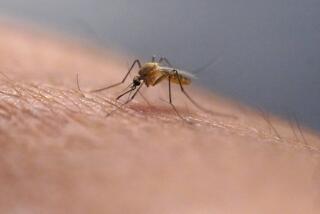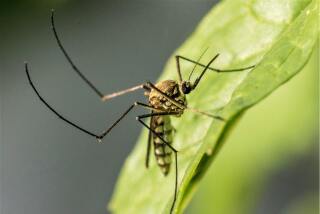Arizona Is Swamped by West Nile
PHOENIX — With triple-digit heat and little rainfall, Phoenix seems an unlikely spot for this year’s West Nile virus epicenter. Yet, federal health officials say Arizona is the only state where the mosquito-borne virus is an epidemic.
“Minnesota may be the land of a thousand lakes, but we’re the land of thousands of abandoned swimming pools,” Will Humble, head of disease control for the Arizona Department of Health Services, said Tuesday.
The swimming pools, irrigation canals that slice through parts of the city, patio misters and lush lawns designed to remind transplants of gardens they left behind have inadvertently turned neighborhoods into oases for mosquitoes.
“It didn’t use to be this bad. You never saw a mosquito,” said resident Gary Clark, 62, who takes his morning walk in an area where a high number of cases have been reported. “It’s even trouble sitting out in your backyard now.”
So far this year, at least 290 of the nation’s more than 500 West Nile cases are in Arizona; three of the 14 deaths this year have been in Arizona. Nearly all the cases have been in the state’s most populous county, Maricopa, which includes the Phoenix metropolitan area.
State health officials estimate at least 30,000 Arizonans may have the virus without knowing it. Some people never have symptoms. About 1% of West Nile victims develop the potentially dangerous inflammation of the brain or spinal cord.
Last year was the first time the virus appeared in areas west of the Continental Divide. It hit Colorado hard and drifted slowly into Arizona’s northeastern tip, then down south.
So far, the primary weapon has been to spray pesticide at night with fogging trucks that roam the neighborhoods. Maricopa County officials recently voted to spend more money to increase spraying.
But they also opted against the aerial spraying recommended by the Centers for Disease Control and Prevention.
“I think it was the right choice,” Humble said. “If you spend $3 to $6 million on aerial spraying, your whole budget is gone in a matter of days. What are you going to do for the rest of season?”
Federal officials say they are watching to see if the county is able to slow the virus’ spread with the fogging trucks.
More to Read
Sign up for Essential California
The most important California stories and recommendations in your inbox every morning.
You may occasionally receive promotional content from the Los Angeles Times.










